How and Why Market Members Anchor Their Canopies
![]()

The canopies, or “tents”, that most of us use at market will shelter us—and our products and customers—from the hot sun and rain. They are the first item members set up when they arrive at market. However all tents are susceptible to being blown over on windy days. Some members anchor them only on the two corners next to their vehicles, but on a windy day this is not enough. Some members have neglected to anchor them at all when the day starts out calm. But a single sudden gust later in the day can can turn a good market day into one you’d sooner forget. This is why the market adopted a rule in 2010 that all tents must be securely anchored every day.
This page displays some of the devices market members use to anchor their tents. There seems to be three basic common types: water jugs, concrete weights, and iron weights, and the photos below are grouped accordingly.
See also “Notes on Tying Down Your Tent” at the bottom of this page.
![]()
Water
Jugs of water are perhaps the simplest and least expensive to create. They are easy to stick in odd corners of the market vehicle, don’t mar items they are packed against, and at around 8½ pounds per gallon, provide significant anchoring if a large enough jug is used. Although a single gallon is not enough for any but the lightest winds, it does provide some anchoring, and multiple jugs can be used at each corner. To create a heavier jug, fill it with sand before filling it with water. But beware that plastic will photo-degrade eventually, so be prepared for the day when your water jug breaks apart. Truly heavy water weights, such as 5 gallon buckets (~45 lbs. each), tend to be large and may be obtrusive in your display area.
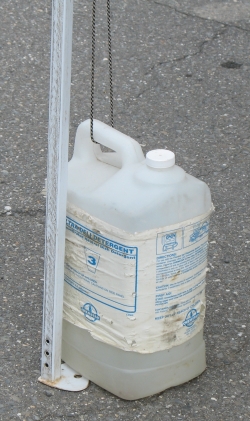
Snakeroot ’07

Living Earth ’07

Argyle Acres ’07
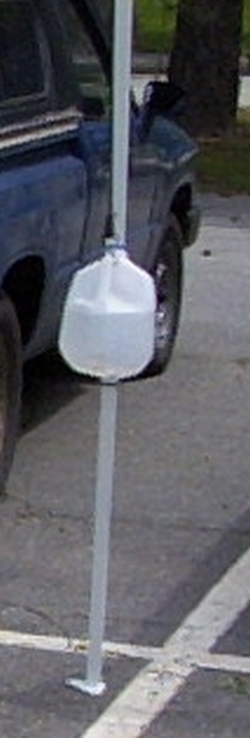
Mineral Springs ’06
 Iron
Iron
Iron is the heaviest weight for its volume, so iron weights can be small yet very heavy. Custom construction my a metal shop can create a slot that fits neatly around the tent leg and install a lifting handle. These designs tend to run over a hundred dollars for a set of four, and weight 40-50 lbs. each, are fairly unobtrusive in use, and will last practically forever. As you can see, in a pinch almost any piece of iron will fill the bill.
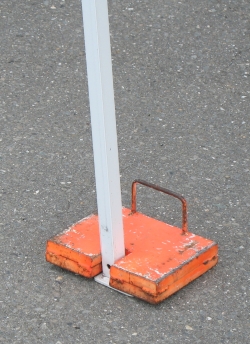
Freyenhagen ’07

Peacemeal ’07
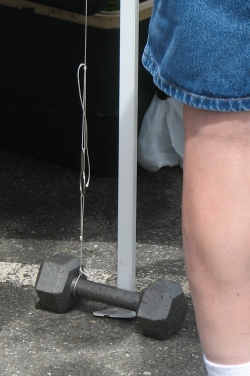
?? ’07
 Concrete
Concrete
Many members use the old reliable concrete block in one of its many forms, while others prefer a more custom designed approach for better looks and ease of handling. Because concrete is heavy, it makes a good anchor. It can be made into almost any form, allowing full sway to the member’s creativity. Note that if using a plastic bucket as a form for your concrete weight, the anchor bolt, and not the much weaker bucket handle, should be where you tie down. The plastic-pumpkin-full-of-concrete weights were made by Argyle Acres’ Galen Young, who offers them for sale. In the late fall, pumpkins-weights can get confusing!

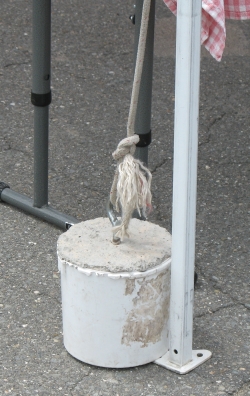
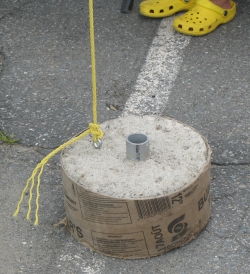
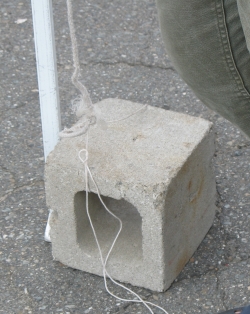
Cornerstone ’07

Meadowsweet ’07

Wickett ’07

Freedom ’07
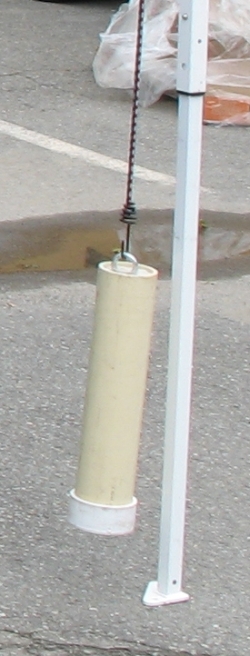
Worcester ’07

Argyle ’07
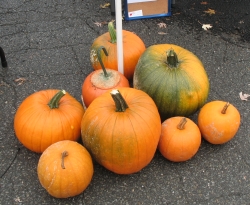
Argyle ’07

Fail Better ’07
![]()
Miscellaneous
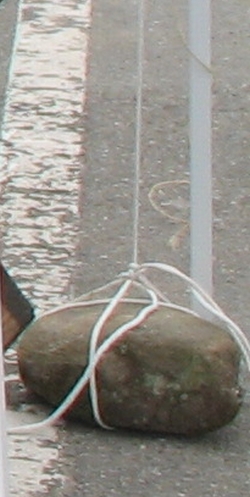
Barkwheats ’07
If your display table is loaded with heavy products at the start of the day, tying your tent to the table is a tempting solution. But if the day’s sales are good, or if your products are light, a sudden gust could bring you double trouble.
Rocks can certainly be heavy enough, and have a definite “home made” look, but require a relatively long time to properly tie at each market and can be awkward to lift and pack in the vehicle.

Notes on Tying Down Your Tent.
- Properly tying down your tent should be considered serious business. Some thought and effort need to be applied to just how to do it responsibly. It may be exciting to a four-year-old to see a gust of wind turn your tent into a kite, but you will consider yourself lucky if your wind-driven tumbling mass of metal struts and canvas misses that laywer’s Lexus, that baby stroller and that elderly couple—and only results in the destruction of your tent, your display and your pride. In other words, you want to be sure your tent isn’t going anywhere.
- A steady wind or a gust of wind will tend to move a tent in either of two ways. One will be sideways so the tent “walks” a few inches. This is usually not much of a problem as long as it doesn’t upset your display or threaten the integrity of your tie-downs. It is, however, an indication that your anchors are nearing their limit for today’s amount of wind. The other way is that one side or one corner of your tent will lift vertically, perhaps beginning with one leg. This is the most dangerous motion, since the tent will now catch even more wind and the lifting effect of the wind will be even greater. This is often the precursor to your tent flipping over and/or blowing away completely. Therefore, when anchoring your tent it is most important that the wind cannot lift any corner of your tent at all. Having your anchoring lines taut helps prevent the wind from even starting to lift a corner. Once your tent is anchored, try lifting a corner leg to see just how well it is anchored.
- It is becoming common for people to use their market vehicle as an anchor for two corners of their tent. This has the advantage of requiring only two further weights to anchor the tent, and you know that at least the two closest corners of the tent aren’t going anywhere. Bungees make this quick and easy, as you can anchor to a bumper, wheel well, roof rack or other fairly sturdy section of your vehicle.
- If using water jugs, a single one-gallon jug at 8½ lbs. is not enough weight to hold down the corner of a tent. Larger 2½ gallon jugs are available, and at 25 lbs. each when filled with water, provide considerably more security. Filling jugs with sand or gravel before adding water increases their weight still further.
- If using bungee cords, don’t use the weak fabric covered ones, as they will stretch allowing your tent to lift off the ground. Plus, they don’t last as long in the sunlight and weather as the black rubber ones, and the hooks are weaker. The best bungee cords are the black rubber ones; use the ones that have two ridges on one side and are square on the other since these are much stronger and last longer than the cheaper oval ones. They are available at truck stops and better hardware stores, and cost $2-4 each, depending on length. They are worth the small investment.
- If using two bungees to obtain the proper length, remove one hook from one and insert the hook from the other bungee into that hole; you now have a one-piece bungee which will reduce fumbling during setup. Also, bend all the the S-hooks closed enough so they won’t slide off the bungee, but not so tight that you are pinching the rubber.
- Advice about using ropes:
- If using rope for your tie-down, use nylon parachute chord or other nylon rope if you can. It is strong, doesn’t fray, and will last in the weather for years and years. Cut your rope to the lengths you’ll need at market then melt the cut ends over a flame to keep them from fraying.
- Cotton clothesline weakens and frays with age, and is miserable to untie when wet. Polypropylene rope is very stiff especially when cold, and becomes rough with age making it difficult to tie and untie.
- Practice tying and untying your choice of rope a few times at home to be sure you’ve chosen the right size and stiffness. A good size rope is about as thick as a pencil or slightly thinner.
- When using rope, learn how to use a trucker’s hitch, also known as the power cinch knot for tying your canopy to your anchor, rather than using a clove hitch or double half hitch knot. Not only is a power cinch quick and easy to tie and untie, but it makes getting your line taut much simpler.
